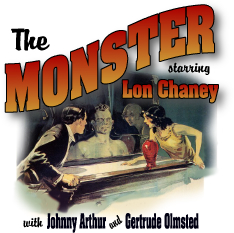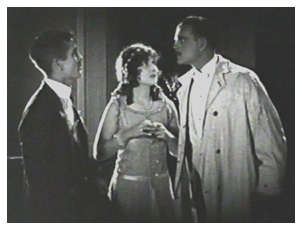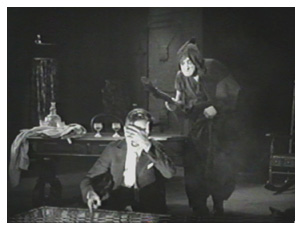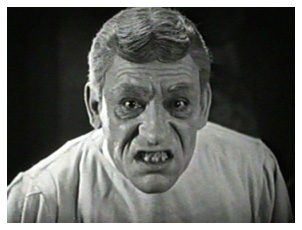

Roland West Productions
Distributed by Metro-Goldwyn Mayer
Directed by Roland West
Cast: Johnny Arthur (Johnny Goodlittle), Gertrude Astor (Betty
Watson), Hallam Cooley (Amos Rugg), Lon Chaney (Dr. Ziska), Charles
A. Sellon (The Constable), Walter James (Caliban), Knute Erickson
(Daffy Dan), George Austin (Rigo), Edward McWade (Mr. Watson),
Matthew Betz (Detective Jennings)
A ghoulish figure lowers a large mirror attached to a rope from a tree down into the road. A car approaches. The driver sees the reflection of his headlights in the mirror. In the darkness of the lonely road, he thinks that an oncoming car is about to hit him head-on, veers to the left and crashes.
The next day, the little town of Danburg is abuzz about
the disappearance of one of their townspeople. Johnny, a hardware
store clerk who is taking a correspondence course to be a detective,
is at the scene of the crash. When the insurance investigator
comes to town, Johnny tries to show him a note he found at the
crash scene that would tie the abandoned sanitarium to the victim's
 disappearance. The constable,
his boss at the hardware store and the investigator brush him
off. Although Johnny and his boss, Amos, are in competition for
the affections of Betty, Betty encourages Johnny to win them over
by doing something "big."
disappearance. The constable,
his boss at the hardware store and the investigator brush him
off. Although Johnny and his boss, Amos, are in competition for
the affections of Betty, Betty encourages Johnny to win them over
by doing something "big."
One evening, Amos and Betty are victims of the same mirror trick on the road and find themselves captive in the old sanitarium by a crazy doctor, Dr. Ziska, who is using residents of the sanitarium to capture victims for his experiments. Johnny is investigating the crash scene that same night and falls through a hole in the ground that takes him through a chute into the sanitarium. All three are now held captive by Dr. Ziska and his muscular, dumb assistant, Caliban. Dr. Ziska is delighted that he finally has a woman on which to conduct his experiments. It is Johnny's "ingenuity" that finally rescues them, saving Betty just as she is about to go under the knife on the operating table, thus winning him the girl and the respect of those who doubted him.
Lon Chaney will always be remembered for some of the greatest performances in cinema history - the hunchback in "The Hunchback of Notre Dame" (1923) Erik, the Phantom, in "The Phantom of the Opera" (1925), and a host of other amazing convincing portrayals as Orientals, gangsters, a tough Marine sergeant, and more. However, some have taken exception to Chaney's appearance in "The Monster" as beneath his dignity. For example, Eugene Brewster, editor and publisher of Motion Picture Classic (May 1925), bemoaned, "After seeing Lon Chaney, the great artist in that wonderful masterpiece, "The Hunchback of Notre Dame," I regret that I was tempted to see him in this. 'How hath the mighty fallen!' He should never have lent himself to such a sad affair."
Admittedly, "The Monster" is a "diversion" for Chaney from his other performances; however, this is one more confirmation of what silent movie fans have always known about Chaney - he was free of vanity or ego and obviously welcomed the opportunity to take on a new challenge - even if it parodies the type of characterization for which he was so well respected.
And that's exactly what "The Monster" is - a parody of the "mad doctor" theme which apparently was "old hat" even in 1925 - but it's a "fun" parody, one that will provide the viewer an hour and a half of spooky, weird and comical entertainment. And all bets are on that Chaney was having just as much fun making the film as we are watching it!
Much about the film is unoriginal; however, when the players
are able to pull it off as well as the cast of "The Monster,"
it doesn't matter. Take Johnny Arthur as Johnny Goodlittle, for
example. He's a wimpish clerk in Watson's Hardware Store in the
small, sleepy town of Danburg. His boss is the slick and dapper
Amos Rugg (ably played by Hallam Cooley). Both wish to win the
affections of the town belle, Betty Watson (the delightful Gertrude
Astor), whose father owns the hardware store. Betty is fond of
Johnny, but, of course, she goes out with Amos because he has
 money and a car. Nothing new yet,
right?
money and a car. Nothing new yet,
right?
When a prominent citizen, John Bowman, disappears after his car crashes on a dark, lonely road one night, Johnny is right there with the constable and others scouring the scene the next morning. Of course it's Johnny who finds a curious piece of paper with "Dr. Edwards' Sanitarium" scribbled on it. But that's not the most intriguing thing about the paper. On the reverse side is the word "help" written backwards so it can only be read in a mirror. Of course, Johnny is the only one who considers this a clue, as no one takes this amateur detective seriously.
The whole idea of a crazy doctor (mad scientist, if you will) using a deserted insane asylum for his experiments on abducted humans is pretty standard fare, too, but, as noted, the cast - in this case, Lon Chaney as Dr. Ziska - still makes it fun to watch. His entourage of weirdos and ghouls is equally as entertaining. The barrel-chested and towering Walter James as Caliban makes an imposing dumb (as in "can't talk") shirtless bodyguard. George Austin, with dark lines creasing his face, a ghoulish face that is framed by his monk-like hood and robe, is the spooky Rigo. On the comical side, we have Knute Erickson as Daffy Dan, acting as loony as he can - for example, asking for a match and then rolling an imaginary cigarette and smoking it.
These are the characters with whom Johnny, Amos and Betty must deal when they find themselves captive in the insane asylum. Johnny ends up there first when he is back investigating the crash scene at night (why at night?) and falls down a chute covered by brush - landing in what appears to be a living room in the asylum. Not long afterwards, Amos and Betty fall victim to the same trick that caused Bowman to crash. Rigo lowers a large mirror by rope from a tree into the middle of the lonely road. As Amos' car approaches it, it appears that another car is coming at him head-on. He swerves and crashes into a tree. Only dazed, they see a light in the sanitarium and go there to use a phone. Once inside, they meet Johnny and learn they are prisoners.
At this point, Dr. Ziska appears - very calm, smiling from ear to ear, and smoking a cigarette in a cigarette holder. The cat and mouse game has begun. He proposes to be the accommodating host, yet our threesome know they are captives - and they can't let on. Because of the storm outside (what else did you expect?), Dr. Ziska insists they must stay the night and are shown to a room that all three must share.
And, yes, you guessed it! There are secret passageways, steel trap doors, and menacing gadgets. For example, when Betty lies down on the bed, we see a large, steel weight begin to lower, slowly threatening to crush her to death. Also, as one would expect, the door is locked - but when they attempt to go to a window, a huge steel panel comes down and shuts off that means of exit. They soon discover a secret passageway through the closet door that leads down to Dr. Ziska's operating room - information that comes in handy later.
A few chilling moments are thrown in, as well. Betty lies
down on a divan in the middle of the room, and we see two arms
come up from beneath her on either side. The arms wrap around
her waist, and she is lowered into the floor and disappears.
Amos looks in a closet for his missing gun and finds nothing.
As he turns his back, the cloth backing in the small closet suddenly
forms  arms and drags him back in - and
he disappears. Lastly, we see Rigo come up behind Johnny with
a club about to hit him over the head. The scene fades before
the blow is struck.
arms and drags him back in - and
he disappears. Lastly, we see Rigo come up behind Johnny with
a club about to hit him over the head. The scene fades before
the blow is struck.
"The Monster," in spite of being a comical parody, doesn't get so silly that the suspense and thrills are lost. Actually, the ending is rather exciting. Johnny is chased by the huge Caliban and goes out a trap door onto the roof, rain pounding and lightning flashing. He almost slides off the roof but catches himself on the gutter. Trying to escape, he does a tightrope walk across a power line high above ground using a piece of the gutter as a balancing pole. Caliban rushes downstairs and out the door, then climbs the light pole to catch Johnny when he arrives. Let's just say Johnny's escape includes a cut power line, an open window, and a very long banister that winds along the stairs down several floors. Good stuff!
Things get really tense when Amos is captive in an electric chair in Dr. Ziska's operating room, and then Betty is wheeled in on an operating table, straps holding her down at the ankles, waist and neck. But where is Johnny? The last we saw of him, he was fighting Rigo outside in the middle of the storm.
It goes without saying that Johnny captures the bad guys, wins the girl and impresses everyone as a real detective.
Although released by MGM, "The Monster" is an not an MGM production. If was produced by Roland West, who also adapted the story and directed it, and a company called Tec-Art. MGM did buy all the rights to the story the next year, though. However, the production values are excellent, and would lead one to believe it was made by MGM. The atmospheric lighting and sets are effective and well done. The direction by West's direction (who also did a commendable job on "The Bat" in 1926 and "The Bat Whispers" in 1930) is above average. And, as noted, the cast is what puts it over the top. In spite of the criticism by publisher Brewster in Motion Picture Classic, fans of Chaney will enjoy his portrayal of Dr. Ziska. Although there are some stock mannerisms, Chaney makes the crazed doctor menacing, not silly. It's classic Chaney as he delights over the woman which his minions have finally brought to him and on which he can now conduct his experiments. It's a bit chilling as we watch him move his hands back and forth over the seductively clad Betty (she's wrapped in what appears to be a sheet) - not only menacingly, but almost lasciviously as he grins his evil grin.
A relative newcomer at the time (he only had three other film appearances to his credit), Johnny Arthur received praise fro several reviewers for his portrayal of Johnny Goodlittle. Ore example, Picture Play said, "Arthur, a new face, makes a real comedy hit." However, we found Arthur somewhat lackluster in the role - doing an adequate job, but lacking the expressiveness needed for the silent screen. Arthur was much more effective as Darla Hood's father in a couple of the Our Gang comedies of the thirties with his whiney voice to add another dimension to his character. Another Arthur - who appeared in MGM films at the time - George K. Arthur, would have been the better choice for the role of the wimpy Johnny Goodlittle. However, as noted, Johnny Arthur's portrayal is adequate for the story.
 Gertrude Olmsted, as the town beauty,
Betty, does a grand job. She is pert and cute and oozes sympathy
as she watches Johnny get brushed off by the insurance detective,
the constable, Amos and the other men when he tries to share the
"clue" he found at the crash scene. She is adorable
as she tells Johnny, "Please do something big so they'll
have to listen to you." Having appeared in 15 or more films
(variously as Olmsted or Olmstead) since 1921, Olmsted was a beauty
who was in demand during the silent era but suddenly quit the
business in 1929 choosing instead to devote herself to being a
wife to director Robert Z. Leonard - to whom she stayed married
until his death in 1968. Two other comedies that are highly recommended
in which she appears are "California Straight Ahead"
(1925) with Reginald Denny and "The Boob" (1926), a
great pairing of her with the aforementioned George K. Arthur.
Gertrude Olmsted, as the town beauty,
Betty, does a grand job. She is pert and cute and oozes sympathy
as she watches Johnny get brushed off by the insurance detective,
the constable, Amos and the other men when he tries to share the
"clue" he found at the crash scene. She is adorable
as she tells Johnny, "Please do something big so they'll
have to listen to you." Having appeared in 15 or more films
(variously as Olmsted or Olmstead) since 1921, Olmsted was a beauty
who was in demand during the silent era but suddenly quit the
business in 1929 choosing instead to devote herself to being a
wife to director Robert Z. Leonard - to whom she stayed married
until his death in 1968. Two other comedies that are highly recommended
in which she appears are "California Straight Ahead"
(1925) with Reginald Denny and "The Boob" (1926), a
great pairing of her with the aforementioned George K. Arthur.
The name of Hallam Cooley is not a standout from the silent era, yet he was a durable player who appeared in over 100 films between 1913 and 1936. The role of Amos Rugg is a typical one for him - mustached, handsome, well-dressed - many times the bad guy and never winning the girl. Although he's more of a coward than a bad guy in "The Monster," we are obviously pulling for Johnny to win the girl, and not Amos. And, of course, Johnny turns out to be the brave one who wins the day, while Amos is the reluctant one when the real test of courage is called upon.
The New York Times wasn't taken with the film noting, "The starch seems to have been taken out of the pictorial conception of 'The Monster' by the inclusion of too much light comedy. . . The thrills that might have chilled one's feet and finger tips end in causing chuckles and giggles. . ."
Other publications, however, did react positively to the film. Harrison's Reports called it "An entertaining comedy and mystery play, of the style of Griffith's 'One Exciting Night.' There are some situations which make one laugh and which, at the same time, hold him in breathless suspense. . . Roland West's direction is masterful; the acting is good, and so is everything else." Photoplay said, "B-R-R-R-R, this one will give you delicious creeps. . . A real thriller." Movie Weekly called it "a thrilling picture" and "Lon Chaney's best part of recent years . . ."
Respected Chaney biographer Michael Blake feels "The Monster" is an unsatisfying film for Chaney fans. "'The Monster' does not hold up well today as a chiller-comedy," he says. "The sets and lighting provide a wonderfully moody and suspenseful atmosphere but the supposed comedy angle causes the film to drag and ultimately to suffer comparisons with similar genre pictures. . . The comedy is neither funny nor original, and whatever suspense that might have been created fails to reach the apex needed to hold the interest of the audience."
The print available for home viewing (through WBshop.com)
is from the TCM library and is excellent quality. A minor downside
is the score which has been compiled from existing music, and,
although effective, isn't as effective as an original score.
Actually, for this comedy-thriller, an organ score would only
seem appropriate.
Copyright 2011 by Tim Lussier. All rights reserved